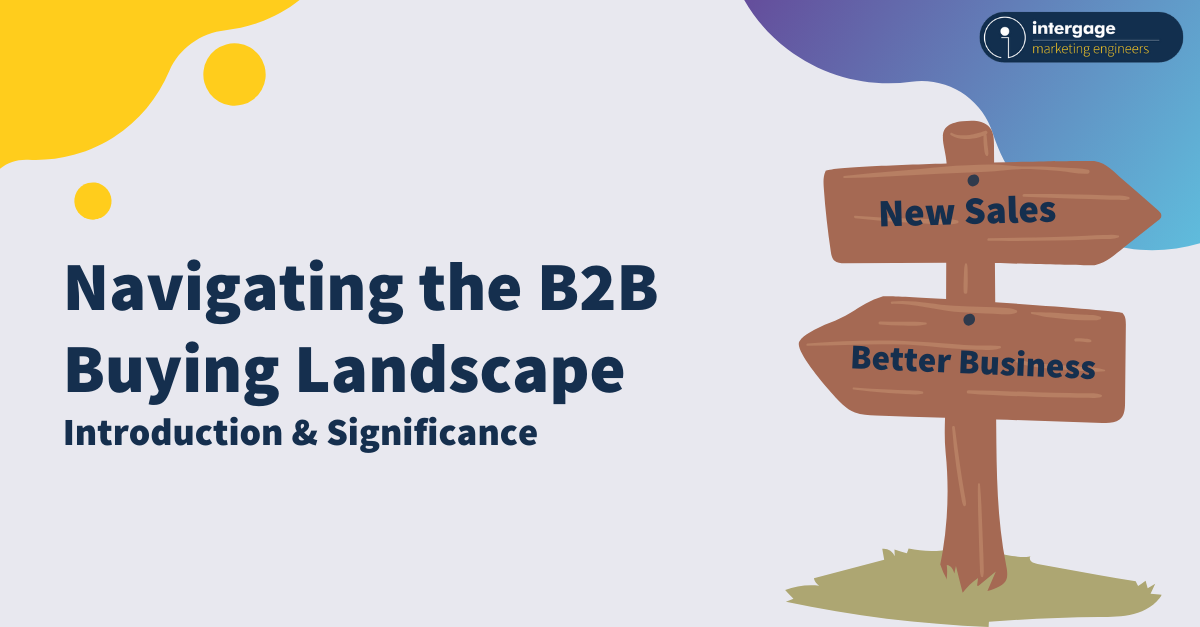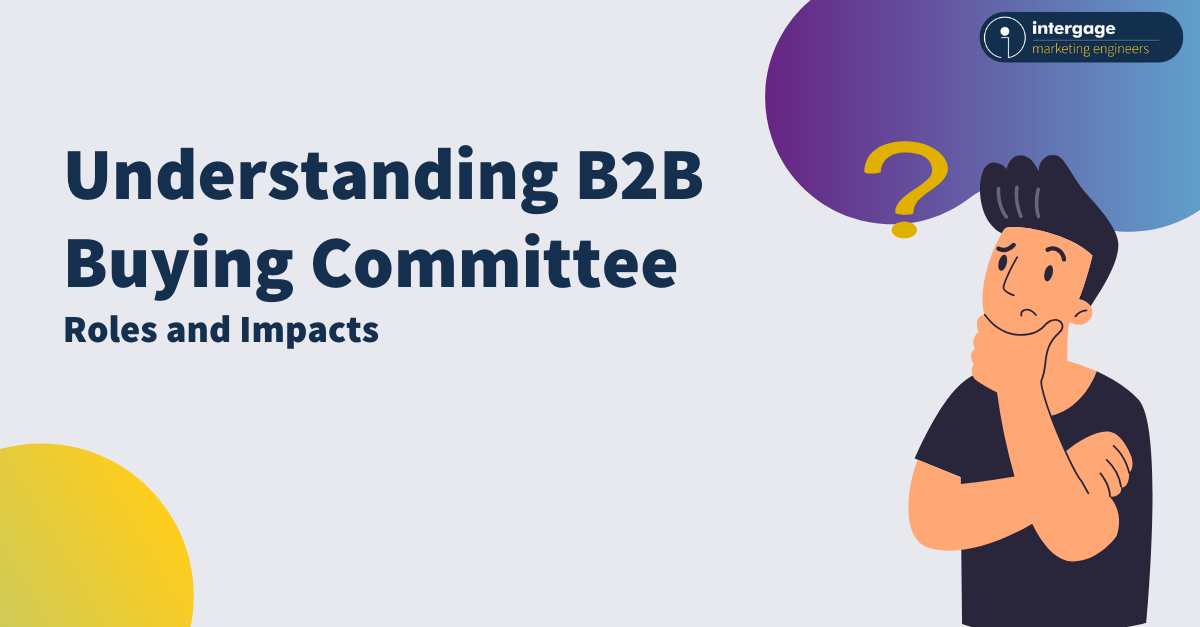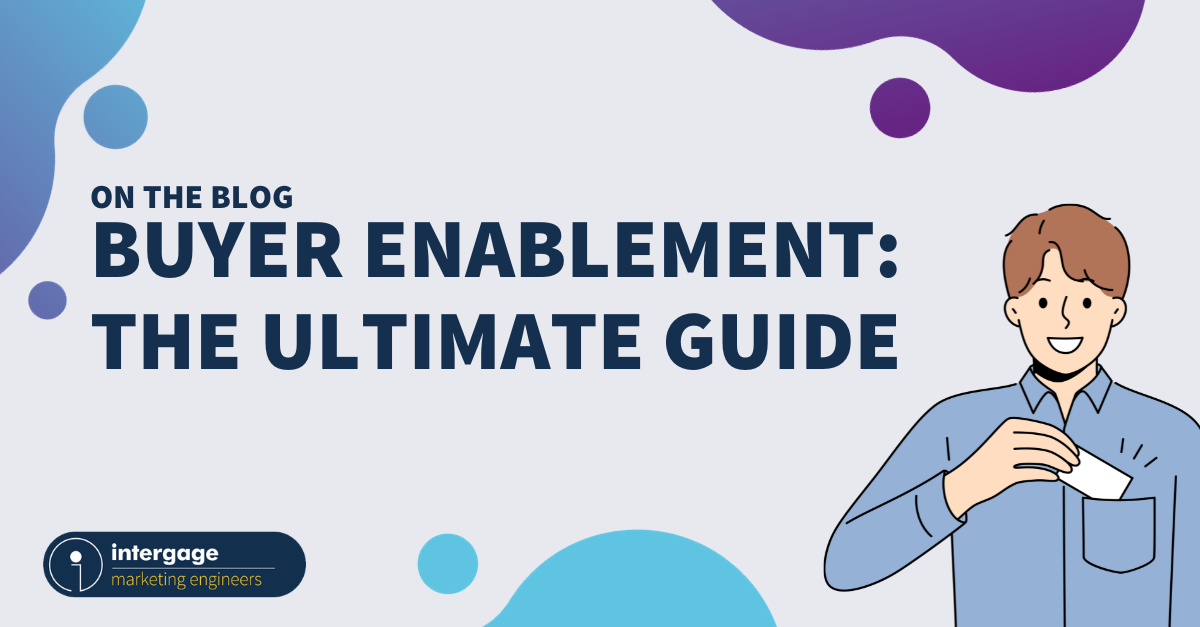A Guide To The B2B Buying Jobs And The Buying Journey
B2B buying isn't a simple one-and-done transaction; it's a complex journey involving numerous stakeholders, each playing a crucial role in the decision-making process. To successfully navigate around its hurdles and pitfalls, both seasoned and aspiring B2B sellers must comprehend the concept of the B2B buying journey and the six distinct buying jobs that shape it.
The Six Buying Jobs in the Modern B2B Buying Journey
To appreciate the complexity of the B2B buying journey, let's break it down into six distinct buying jobs, each with its own set of challenges and considerations:
Problem Identification
This is where it all begins. In this phase, someone within the organisation identifies a problem or need that requires attention. This person might be a member of the company's leadership team, a department head, or an employee on the front lines. Their role is to recognise the issues that must be addressed to improve operations or achieve strategic goals.
Solution Exploration
Once a problem is identified, the buying committee begins the search for potential solutions. This stage involves extensive research and evaluation of various products, services, or strategies that could address the identified problem. Members of the buying committee, including the champion and influencers, actively participate in this phase, seeking the best-fit solution.
Requirements Building
With potential solutions in mind, the buying committee proceeds to outline its specific requirements and criteria for selecting a supplier. This step is vital for ensuring that the chosen solution aligns with the organisation's unique needs and objectives. The decision maker and influencers play a critical role in defining these requirements.
Supplier Selection
After establishing clear requirements, the organisation evaluates potential suppliers or vendors. The decision maker takes the lead in this phase, considering factors like pricing, product features, reputation, and more. The champion, as well as influencers and blockers, may provide input and recommendations.
Validation
Once a supplier is selected, the organisation delves into validation. This entails a comprehensive assessment of the chosen supplier's capabilities, including references, case studies, and demonstrations. The influencer and champion may actively participate in the validation process, lending their expertise and insights.
Consensus Creation
Finally, consensus creation is the glue that holds the buying journey together. This step involves aligning the various members of the buying committee—each with their unique roles and interests—around a collective decision. Achieving consensus is often challenging due to conflicting viewpoints and priorities within the committee. The decision maker, influencers, champions, and even blockers all influence the consensus-building process.
How do these buying jobs contribute to decision-making?
The six B2B buying jobs within the modern B2B buying journey are interlinked and collaboratively contribute to the decision-making process. Understanding how these jobs connect is crucial for sellers seeking to navigate this complex terrain effectively.
It’s important to consider that these buying jobs don’t happen in isolation; they involve continuous communication and collaboration among stakeholders as discussed in our guide to buyer enablement.
Let's explore how these jobs interconnect and shape the decision-making process:
|
Buying job |
Connection to decision-making |
|
Problem Identification |
This initial step sets the stage for the entire buying process. The identified problem serves as the catalyst for the subsequent buying jobs. Without a clear problem to solve, there is no basis for making a decision. |
|
Solution Exploration |
Solution exploration informs decision-makers and influencers about the available options. It provides the groundwork for evaluating alternatives and making informed choices. |
|
Requirements Building |
This step ensures that the decision-makers have a clear understanding of what the solution needs to achieve. It sets the standards against which potential suppliers or vendors will be evaluated. |
|
Supplier Selection |
Based on the requirements outlined in the previous job, stakeholders can assess potential suppliers' capabilities and offerings. This evaluation contributes to the final decision by narrowing down the choices. |
|
Validation |
Decision-makers, often in senior leadership roles, play a critical role in validating the chosen solution. Their approval provides the necessary endorsement for moving forward. |
|
Consensus Creation |
The decision-making process culminates in consensus creation. It ensures that all stakeholders are on board with the chosen solution, addressing concerns, and aligning their support. |
The Buying Committee's Role
Throughout these buying jobs, different members of the buying committee come into play. The champion actively supports the solution being considered, while influencers provide valuable insights. The decision maker holds the ultimate authority, and blockers may raise objections.
Understanding the dynamics and relationships within the buying committee is crucial for B2B sellers. Each member contributes to the decision-making process, and their roles can impact the success or failure of a deal.
In this intricate landscape, B2B sellers must tailor their strategies, messages, and resources to align with the needs and motivations of each buying job and committee member. Recognising the significance of the B2B buying concept, the complexities it entails, and the roles of the six buying jobs is the first step toward achieving success in this competitive arena. Stay tuned as we delve deeper into each buying job, providing insights and strategies to help you navigate the B2B buying journey effectively.
But what about the buying journey stages?
You might think that keeping track of the six buying jobs is complicated enough but you also need to consider the different stages of the buying journey which go along-side these buying jobs.
Typically, the buying journey is depicted as a linear process with the following stages:
Unaware
In the unaware stage of the buying journey, potential buyers have not yet recognised or identified any specific problems or needs. They are not actively seeking solutions or products. They may not even be aware that a solution or product exists to address a potential need.
Individuals in this stage lack awareness of their pain points or challenges. They have not engaged in any research or information-seeking related to potential solutions. Marketing efforts at this stage aim to create awareness and capture the attention of this audience.
Problem Aware Stage
The problem aware stage signifies that potential buyers have identified a specific problem or challenge they need to address. They acknowledge the existence of an issue but may not have explored potential solutions or products yet.
Individuals in this stage have a clear understanding of their pain points but have not delved into detailed research about how to solve them. They are looking for information that helps them define the problem further and understand its implications. Content and messaging should focus on problem exploration.
Solution Aware Stage
In the solution aware stage, potential buyers recognise that various solutions or approaches exist to address the problem they've identified. They are actively seeking information about different solutions and considering their options.
Individuals at this stage are researching and comparing potential solutions, trying to determine which one aligns best with their needs and goals. They may be evaluating the pros and cons of different approaches. Marketing efforts should provide valuable information about solution categories and benefits.
Product Aware Stage
The product aware stage represents the point in the buying journey where potential buyers are not only aware of their problem and potential solutions but have narrowed down their choices to specific products or services. They are actively evaluating these offerings.
Individuals in this stage are conducting detailed product research, comparing features, pricing, and reviews. They are looking for specifics about how a particular product or service meets their needs. Marketing and sales efforts should focus on showcasing product differentiation and value propositions.
Linking the jobs to be done with the stages of the buying journey
So, how do the buying journey stages link with the six jobs to be done?
The truth is, it’s not as simple as overlaying one onto the other. As mentioned previously, the jobs to be done aren’t linear like the stages of the buying journey which makes things all the more complex.
The way in which the buying jobs link with the stages of the buying journey will vary greatly and there really is no one-size-fits-all approach so we won’t pretend there is.
For example, it’s likely your audience will become aware of lots of different solutions and products throughout their buying journey and each time this happens, they’ll need to explore those solutions and build requirements. Equally, your buyers may go through all the buying jobs before realising they actually misdiagnosed their problem at the very start.
You can see why modern B2B buying is so challenging and why so many buyers decide that the pain of change and the fear of messing up is just too great, causing decision paralysis. In fact, 94% of buyers experienced a cancelled purchase cycle, ending in “no decision (Gartner).
What challenges are B2B buyers facing?
The B2B buying journey is hard. Gartner’s recent research revealed that 77% of B2B buyers state that their latest purchase was very complex of difficult. We’ve already discussed the complexity of the buying committee, the buying journey and the jobs that buyers need to get done in order to make a purchase. It’s a lot to navigate and more often than not, buyers struggle with a fear of messing up.
Every decision is scrutinised and revisited with 95% of buying groups reporting having to go back and revisit decisions at least once as new information emerges (Gartner).
Let’s talk about some of the more specific challenges your buyers are facing which will be having a huge effect on your ability to close deals.
Too many cooks
As we know, the typical buying group involves six to 10 stakeholders (Gartner). Each of these people comes to the table with their own conflicting experience, challenges and attitudes toward certain solutions. Often, these buying groups need to deal with conflict, resolution management and aligning members of the team which is a huge amount of work.
This is often the reason buying decisions aren’t made. Lack of consensus creates paralysis meaning the champion or person driving change is left to accept that driving a decision is more painful than continuing to ‘muddle along’ with the current challenge.
Complexity of purchases
B2B problems often lack straightforward solutions, requiring extensive research into various approaches. B2B solutions are also usually high-ticket purchases which adds another layer of fear for buyers due to the ‘fear of messing up’.
These complex, high-ticket solutions require a huge amount of research, input from multiple people and often simulations and calculations that help predict ROI and suitability.
Sounds like a lot of work, right?
Strategic convergence
In one of our recent blogs, we discuss that 64% of customers cannot tell the difference between one B2B brand’s digital experience and another’s (Gartner). We refer to this as strategic convergence, which happens when suppliers begin to replicate perceived market leaders, resulting in many suppliers looking and sounding the same. This makes it really difficult for buyers to identify a supplier that truly understands their challenges and needs. Yet another blocker to make a decision.
Validating suppliers
We’ve already discussed there being a lot at stake when it comes to making B2B buying decisions. As a result of this, buyers often want detailed information on the legal, technical and financial aspects of a purchase which can be incredibly time consuming. This is also content that isn’t readily available from suppliers meaning buyers need to start engaging with sales people who often, aren’t equipped to answer these difficult questions.
Creating consensus
The sheer amount of information a B2B buying team is exposed to in the buying process is immense. Each time a new piece of information is uncovered, the buying committee needs to be consulted which makes creating consensus incredibly difficult. This is one of the major blockers for buying decisions. B2B suppliers who don’t provide content up-front will be making this process even more difficult for their buyers.
How can you help B2B buyers make decisions?
B2B buyers need a trusted guide to help them through the buying process. However, they need this help on their terms without needing to speak to an actual person. They need to be able to self-educate, share content with their buying committee and prove that your solution is the one they should choose.
The key to helping B2B buyers make decisions is creating hubs of content that are easily accessible, simple to share and contain the information up-front for them to:
- Understand the solutions available for their challenge
- Compare your solution against others
- Build their requirements
- Understand the risks and benefits of a solution
- Answer difficult questions internally relating to technical, financial and legal topics
- Build a business case including ROI for your product
The shape and size of this content will change depending on who it’s for in the buying committee, your solutions and the industry you’re working in. Don’t feel like you need to stick to classic written, graphical content either. Experiment with calculators, simulators, diagnostic tools, benchmarking tools and other forms of interactive content.
Ultimately, this content needs to help the buying committee make a buying decision.
As a minimum, this buyer enablement content should be:
- Relevant
- Easy to consume
- Useful
- Credible
Bonus points if it also:
- Is easy to share
- Provides confidence
- Aligns to the customers’ emotional needs
- Leads back to your unique differentiator.
Buyer enablement content example
To give you an idea on what buyer enablement content looks like, I’m happy to share some information on one of Intergage’s own buyer enablement hubs.
One of our major products is our marketing retainers which focus on four different objective; growth, optimisation, launching new products/services and delighting existing customers. We refer to this as GOLD. We’ve created a whole host of content to help buyer sell this concept into their buying committees. It includes information on:
- An introduction to marketing retainers
- The alternatives to using a marketing partner like Intergage
- Identifying an ideal customer profile
- How to set marketing budgets
- Questions to ask an outsourced marketing partner
- How to measure success
- What makes a good client for a marketing retainer
- How to get internal buy-in
- A breakdown of what’s included in our GOLD retainers
- What working with us actually looks like
- Results from other companies that have marketing retainers with us
- Video testimonials from current retainer clients
This information comes in a variety of mediums, is easy to share and actively helps buying committees make buying decisions.
We discuss content creation for buyer enablement further in this guide.
To conclude
In this guide, we’ve discussed the nuances of the ever-more complex buying journey and the impact complex buying teams have on the modern B2B buyer’s ability to make buying decisions.
They key is to get to know your buying committees and the journey your buyers go through as well as possible. Want to close the gap between you and your buyers? Check out our approach to buyer enablement here and book a place on our upcoming FREE buyer enablement workshop.





